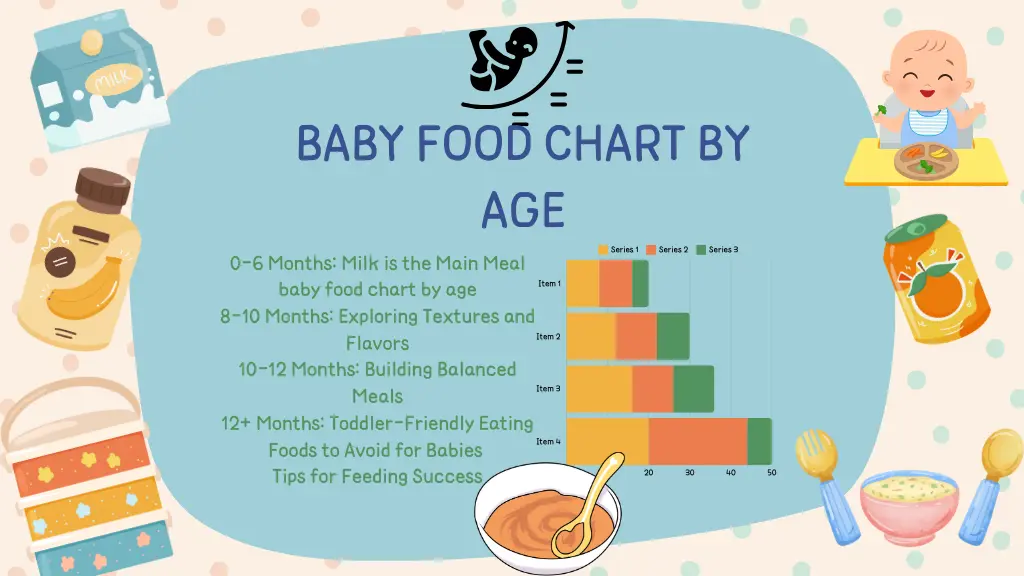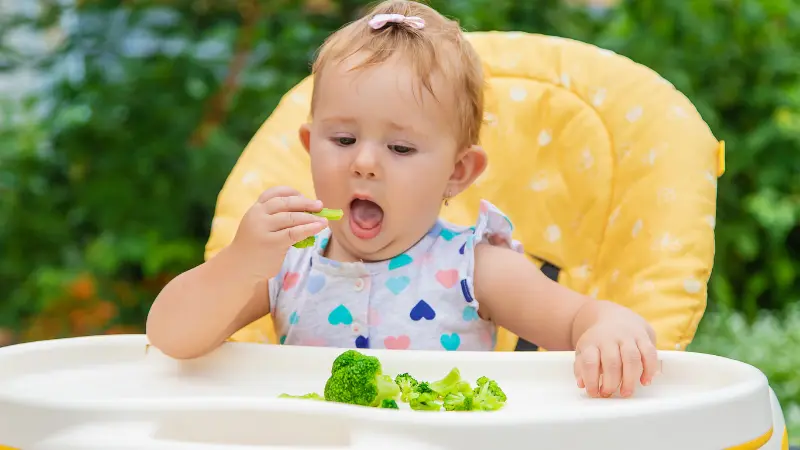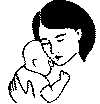Baby food chart by age is an essential guide for parents looking to introduce solid foods at the right time. Knowing when and what to feed your little one can be tricky, but with the right plan, you can ensure your baby gets the necessary nutrients.
At 6 months, start with single-ingredient purees like applesauce or mashed sweet potatoes. At 8 months, try soft finger foods like small pieces of banana or avocado. By 12 months, your baby can begin eating most family meals cut into small pieces.

In this article, we’ll break down age-specific food recommendations, tips on portion sizes, and advice on allergies. Keep reading for a stress-free feeding experience for you and your baby!
0-6 Months: Milk is the Main Meal
During the first six months, your baby’s tummy is tiny, and their needs are simple. Breastmilk or formula is all they need to grow strong and healthy. It’s like their superfood—packed with all the nutrients, vitamins, and antibodies they need to thrive.
How Much Milk Does Your Baby Need?
Here’s a quick chart to help you understand how much milk your baby might need:
| Age | Feeding Frequency | Amount per Feed |
| 0-1 Month | 8-12 times a day | 1-3 ounces |
| 1-3 Months | 6-8 times a day | 3-5 ounces |
| 4-6 Months | 4-6 times a day | 6-8 ounces |
Pro Tip: Look for hunger cues like lip-smacking, rooting, or sucking on fists. And don’t stress if your baby doesn’t follow the chart exactly—every baby is unique!
Baby Food Chart by Age: Starting Solids
Around 6 months, your baby will start showing signs that it’s ready for solid foods. Maybe it’s sitting up, showing interest in your food, or seeming hungrier than usual. This is where the fun begins!
6-8 Months: First Tastes of Solid Food
At this stage, think simple and smooth. Start with single-ingredient purees to help your baby explore new flavors without overwhelming their tiny taste buds.
| Food Group | Examples | How to Serve |
| Fruits | Banana, Apple, Pear | Mashed or pureed |
| Vegetables | Sweet Potato, Carrot | Steamed and pureed |
| Grains | Rice Cereal, Oatmeal | Mixed with breastmilk or formula |
Fun Fact: Did you know sweet potatoes are a favorite first food? They’re naturally sweet and packed with vitamins!
8-10 Months: Exploring Textures and Flavors

By now, your baby is probably a pro at eating purees. It’s time to mix things up! Introduce thicker textures, soft finger foods, and a variety of flavors.
What to Feed Your Baby?
| Food Group | Examples | How to Serve |
| Fruits | Avocado, Mango | Mashed or small chunks |
| Vegetables | Broccoli, Zucchini | Steamed and chopped |
| Proteins | Chicken, Tofu | Shredded or mashed |
| Grains | Pasta, Toast | Small, soft pieces |
Parent Hack: Let your baby explore food with their hands. Yes, it’ll be messy, but it’s an excellent way for them to learn!
10-12 Months: Building Balanced Meals
Your baby is almost a toddler—how did that happen? They’re ready for more balanced meals that include fruits, veggies, proteins, and grains at this stage.
Sample Meal Plan
| Meal | Food Ideas |
| Breakfast | Scrambled eggs + banana slices |
| Lunch | Shredded chicken + steamed carrots |
| Dinner | Mashed sweet potato + small pasta pieces |
| Snacks | Soft fruit chunks, yogurt, or crackers |
Tip: Offer water in a sippy cup with meals to help them stay hydrated.
12+ Months: Toddler-Friendly Eating

Congratulations, you’ve made it to the toddler stage! Now, your little one can enjoy most of the same foods as the rest of the family (with a few tweaks for safety).
What to Feed Your Toddler?
| Food Group | Examples |
| Fruits | Berries, Melon, Orange slices |
| Vegetables | Steamed broccoli, Cucumber sticks |
| Proteins | Grilled fish, Lentils, Cheese |
| Grains | Whole-grain bread, Rice, Quinoa |
Parent Tip: Toddlers can be picky eaters, so keep offering new foods—even if they initially refuse them.
Foods to Avoid for Babies

Not all foods are safe for babies. Here’s a quick list of what to avoid:
- Honey: Can cause botulism in babies under 1 year.
- Cow’s Milk: Stick to breastmilk or formula until 12 months.
- Choking Hazards: Nuts, popcorn, whole grapes, and hard candies.
- Added Sugar and Salt: Babies don’t need it, and it’s not good for their tiny kidneys.
Remember: Always supervise your baby during meals to prevent choking.
Tips for Feeding Success
Feeding a baby can be messy, fun, and sometimes frustrating. Here are some tips to make it easier:
- Be Patient: It’s normal for babies to make funny faces or spit out food.
- Follow Their Cues: Let your baby decide how much to eat.
- Make It Fun: Use colorful plates or sing songs during mealtime.
- Stay Consistent: Offer a variety of foods regularly.
Pro Tip: Keep a bib and wet wipes handy—you’ll need them!
Conclusion: Growing with Your Baby
Feeding your baby is more than just filling their tummy—it’s about helping them grow, explore, and develop healthy eating habits. Remember, there’s no one-size-fits-all approach. Your baby is unique, and their food journey will be, too.
So, take a deep breath, grab a spoon, and enjoy this special time with your little one. Before you know it, they’ll be stealing food off your plate!
Do you have questions or stories about your baby’s eating adventures? Share them in the comments below—we’d love to hear from you!
